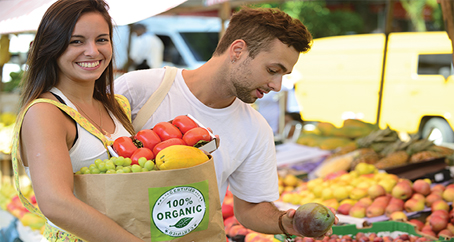Organic food is a source of passionate debate. Proponents believe there are ethical and health reasons to grow and consume organically produced fruits and vegetables; others believe certification and more complex farming practices are unnecessary burdens for growers, creating undo expense for consumers. What can’t be disputed is over $39 billion in retail sales for organic food products in 2015—and how they have become a fundamental part of many consumers’ shopping habits.
This is especially true for millennials. As Bob Scaman, president of Goodness Greeness, Inc., an organic produce distributor in Chicago observes, “Millennials, who have been brought up on organics, are the first generation to expect them as the norm.”
Organics, once just a sliver of food and other sales, are here to stay. Explore the growing regions, trends, challenges, and more behind this intriguing category.
Sources Expanding
To ensure a steady supply of fresh organic fruits and vegetables, distributors and wholesalers shop the world. Janice Honigberg, president of Sun Belle, Inc., a marketer and shipper located in Chicago, sources both conventional and organic berries. Blueberries, for example, come from Chile as well as Florida, Georgia, North Carolina, Michigan, Mississippi, and the Pacific Northwest. “Mexican and Peruvian production is also growing,” she notes, adding, “all of these regions have become significant sources of organic berries as well.”
“Until a few years ago,” explains Scaman, “organic was U.S.-centric; our imports versus domestic are about fifty-fifty. With the emergence of growers in Mexico, it’s amazing how much production has increased south and north of the border—Chile, Argentina, Peru, Costa Rica, Canada, as well as New Zealand, Israel, and Holland. When it comes to organics, it’s a world market.”
Nelly Czajkowski is the organic category manager at DiSilva Fruit, a division of Arrow Farms, Inc. located in Chelsea, MA. “We still source mostly from U.S growers in California and Florida,” she notes. “We handle avocados from California and Mexico depending on the season. For crops like potatoes and onions, we work with East Coast growers whenever possible. Most of our sources are domestic, but we do business with Canada and Peru to keep supplied all year.”
Market Expansion
Although the modern organic movement has been around since the 1970s, there are still roadblocks from field to fork. Not only is organic growing an expensive process, but it’s very labor intensive, herbicides and most pesticides are prohibited, and yields are lower than conventional growing. Government regulation, documentation, and certification can also be arduous. Yet with climbing demand, more growers across the country are taking the plunge—and conventional growers are adopting many of the same practices but stopping short of organic certification.



